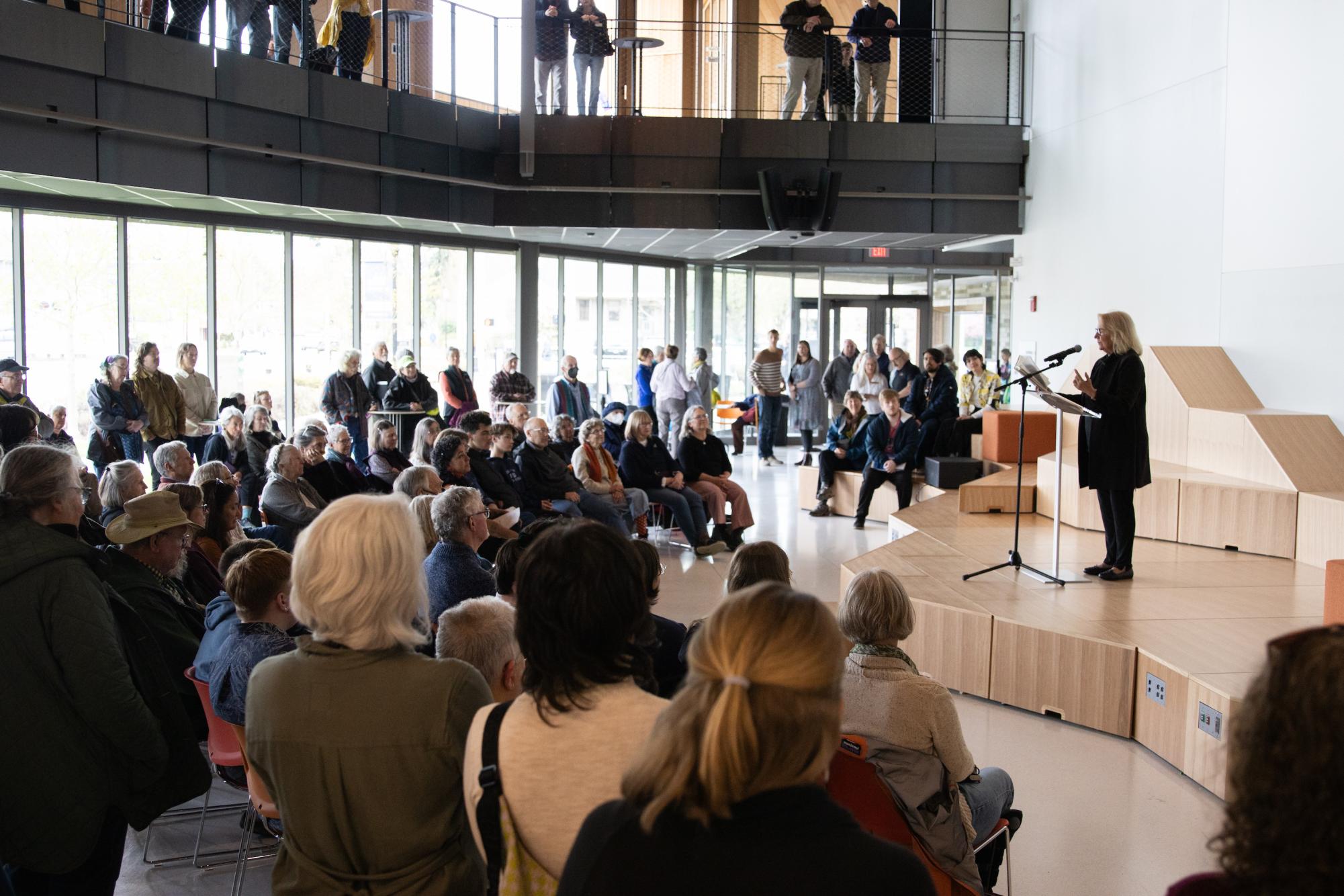The first proposal for an arts building at OSU came in 1909; now, 115 years later, The Patricia Valian Reser Center for the Performing Arts (PRAx, for short) is the culmination of that dream.
“We’re finally doing what we’ve been planning to––the whole reason we’re here is being made legitimate,” said Peter Betjemann, the Patricia Valian Reser Executive Director. “Opening the doors to the public is an incredible feeling.”
PRAx was packed with attendees who explored the new space for the very first time, experiencing the 490-seat Lynne Hallstrom Detrick Concert Hall, the Edward J. Ray Theater, the Kate and John Stirek Gallery, the Austin|Parrish Arts Plaza, the Dixie Luana Wooton Kenney Garden and the Rehearsal Classroom Building.
Tiffany Cochran, PRAx’ marketing and digital communications specialist, said 1,000 people attended the opening within the first hour.
Betjemann said it feels “powerful” to represent PRAx’s mission, which is to create public-facing, accessible art, as well as transparency. The building’s open layout and expansive windows welcome natural light in its spacious Thomas W. Toomey Lobby, creating a literally transparent space.
“If we had made an arts building in 1909, we would have a building that reflected the arts culture of 1909,” Betjemann pointed out. “In some ways (PRAx) arrives at perfect timing in the sense that it’s a super high tech building, and forms of artistic expression are becoming more and more technologically mediated and driven.”
According to Betjemann, students coming to performances is a major goal. Thankfully, PRAx will provide $5 student tickets across the board, regardless of the regular cost of admission for the general public. Furthermore, after noon on the day of a show, students can come to PRAx and pick up remaining tickets for free.
Larry Rogers, the dean of the College of Liberal Arts, said PRAx is a “student space” where all students, regardless of arts-involvement, are not only welcome but also wanted.
“It’s a student-facing, student-friendly, student-focused facility,” said Rogers. “What we’re trying to do is to say ‘this is your space, this is your university, and even if you’ve never come to a show or you’ve never been in an art museum or an art gallery, this is your chance to experience it because it’s your place.”
PRAx also brings a multidimensional, interdisciplinary perspective to the Corvallis community too, according to Rogers.
“Our goal is to transform the university by embedding arts into not just performances and paintings and all the things you affiliate with art, but embedding art into everything…” said Rogers. “This is a hot new ticket in town, and a hot new ticket in the region.”
Betjemann and Rogers both emphasized that PRAx also plans to bring their featured artists to the classroom, where students can learn from their perspectives and expertise before attending shows and exhibitions.
“For example, we’re seeing a jazz Indigenous trumpeter, and he spent all week in our classrooms with our music students this week, connecting with them and helping them with their own practices,” Rogers said.
PRAx will feature experimental and interdisciplinary performances as well as diverse artists like opening-night performers Diné jazz artist Delbert Anderson and his quartet. In fact, PRAx plans to explore Indigenous history through jazz in a multi-year project.
According to the PRAx website, they’re committed to booking Native artists and encourage their audiences to continue supporting Indigenous artists. They’re also partnered with the Patricia Reser Center for the Arts in Beaverton, and will collaborate on programming, content, and student engagement. More about the PRAx mission can be found here.
One of the ways PRAx selects its artists is through major conferences, where artists showcase abridged versions of their performances. Betjemann said he attends these events and will bring back selections to discuss with the PRAx team so they can create a season of art that appeals to a broad audience.
“We’re not an all-classical music facility, we’re not an all-jazz music facility, we’re not an all art and science music facility…we’re all of those things,” Betjemann said.
Student opportunities include four weeks featuring student arts at the end of each term; according to Betjemann, music department student ensembles will be able to perform showcases at PRAx, and the centrally located student arts corridor was “fundamentally designed” for artwork created by students.
Betjemann said they’re still sorting out the details in terms of student exhibitions and hope to work more closely with student government to get the pieces in order. He said they also hope to be able to feature more cultural nights in collaboration with student organizations.
Betjemann recommended several upcoming experiences for students and community members to attend, including Los Angeles band Las Cafeteras, who sing in English, Spanish and Spanglish alongside “Afro-Mexican beats.” They will be performing at PRAx’s Detrick Concert Hall on April 28th.
Another upcoming experience Betjemann highlighted is Slumberland, created by Bombina Bombast, a Swedish performing arts company. Slumberland will give attendees a chance to experience “live virtual reality in which the audience will wear VR headsets to interact with each other and a live actor in a motion capture suit.
Betjemann said this performance explores the way children’s sleep patterns have been impacted by the digital age and used the commentary of 140 children to create the piece. PRAx even partnered with the Corvallis-based company Oregon Coffee and Tea to make a special tea that promotes sleep and will be served in concert with Slumberland’s 38 performances taking place between April 22nd and May 11th.
“When you come out of the VR experience, it’s a little intense to come back to the real world,” said Betjemann. “So we’re going to give everybody a cup of tea and there’s going to be an onboarding room and then an offboarding room.”
According to Betjemann, PRAx’s next season will launch with Rising, a to-be-announced contemporary dance performance about rising ocean temperatures and raising awareness of how the oceans’ conditions impact the ecosystems of the whole globe.
PRAx was primarily funded by the Reser family of Reser’s Fine Foods, the same family whose name is familiar to anyone who’s seen Reser Stadium. Two major endowments, $5 million to fund the arts and $25 million to kickstart construction, helped propel PRAx’s $75 million building from concept to reality.
Details for upcoming performances, residencies, and other info can be found at PRAx’s website.












































































































